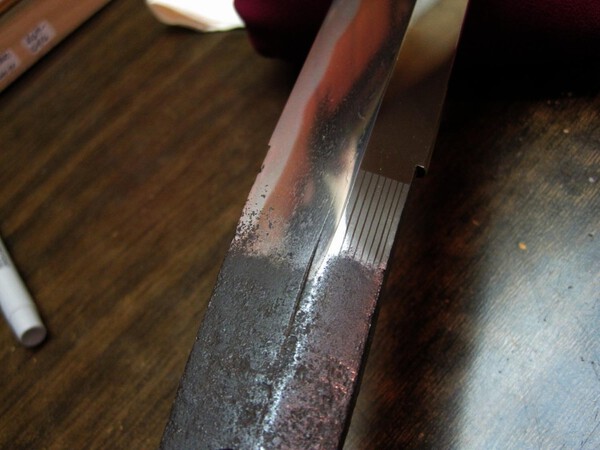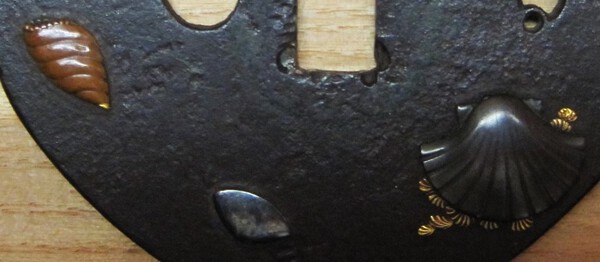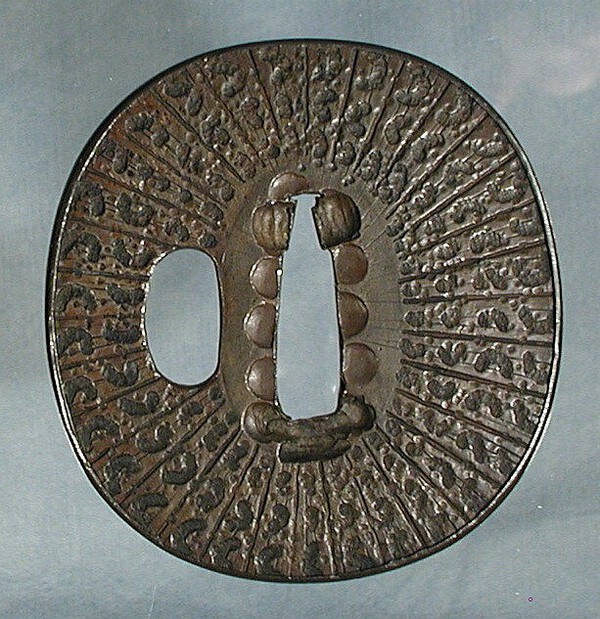-
Posts
703 -
Joined
-
Last visited
-
Days Won
4
Everything posted by Ron STL
-
No photo to share at this time, but I'm looking for any information (illustrations of his work) of the artist who signed: Yoshitoshi Kizamu or as in Kinko Meikan, Hoboshi Yoshitoshi Kizamu (p.602c)? He is not listed by Haynes. His mei is on a beautiful kinko kozuka showing Mount Fujiyama in gold iroe style. Marcus shows his mei and places his working 1908-58.This kozuka was with a mounting brought back post-war and one I purchased back in the early 1970s. Strange, but only now have I realized how "new" the kozuka actually is. Unlikely to find another example of his work I'm sure, I thought it might be worth asking about. Ity always amazes me what NMB members come up with. Yoshitoshi definitely did beautiful work. I can post a picture if anyone is interested, later. Ron STL
-
Okay, I checked on a kozuka here that is unsigned, quite worn, has worn away uttori overlay, etc., that I figured was ko-Goto work. To my surprise and delight, there are the single dew drops except for on leaf with two dew drops just as Pete wrote. I learned something today, yea. Sorry for the poor photos. The condition in hand is nicer than what it looks like on the photos. Ron STL
-
Yes, great info regarding the dew drops. Now I'll need to go look at a few of my own items! Ron STL
-
Okay, on to the what story this tsuba depicts. Can anyone tell me what tale this tsuba depicts? I think it is something to do with the "cuckoo and setting sun" but I'd like to be more positive about this. Anyone??? Ron STL
-
I've been trying to find more information on a favorite tsuba that I've had for years. It is signed: Masayoshi (kao) and depicts "bird, clouds, moon" theme. A lovely work, it received Tokubetsu Hozon several years ago when sent to shinsa. The origami simply states the mei with kao, so for a long time I was curious as to who Masayoshi was. Searching Marcus's fittings artist signatures, I've match the kao to the name which placed the work of Masayoshi, Mito Ichiryu school, late Edo. More searching yielded a similar NMB topic in which John Stuart shared a lot of information about Mito schools. I'm hoping John or others could elaborate more on this specific group and perhaps, Masayoshi himself. The "late Edo" placement surprised me since the tsuba looks older, but it reads like this group's work resembled Nara work, which might explain the feeling this tsuba gives out. Thought it would be worth asking... Ron STL
-
The marumune on this mumei naginata-naoshi daito does not look particularly "high" but more low or what I'd call "normal." The sword has been called den Naoshizu which should put it into Nambokucho era. At present, it is in Japan awaiting Tanobe sayagaki and later, submission to this year's Juyo shinsa. Not a sure thing, but I'm told worth the submission. A stateside shinsa assigned it to a sue-koto Mihara smith. Differences of opinions, but the Naoshizu fit more with our original judgement of the sword. Once before I submitted a marumune sword for a friend during an earlier stateside shinsa and I "think" that one was judged sue-koto. Perhaps sue-koto did produce some marumune blades but sometimes I think a "late" call is safer than pushing a work back a few hundred years. All opinion... Ron STL
-
Regarding the kikumon carved on swords by shodai Hisakuni. The late Cary Condell dealt with this topic in his kantei discussion of shodai/nidai Hisamichi. (Conundrom 4 - JSS/US newsletter) It was specifically noted that shodai carved his kiku in a clockwise manner whereas nidai carved them counter-clockwise (prior to his using the stemmed kikumon). I'm pretty sure this change (in direction) in carving the single kikumon was when nidai started to sign for his father, but I've not been able to find proof of this "written" anywhere but in this conundrum. This change is clearly seen in the various books, but if this is noted, it's noted in Japanese and not detailed by an example. Can anyone point out where this kantei detail is clearly noted. There is a Hisamichi on AOI's site which shows the CCW direction but the sword is called shodai without any notation about this detail. Any help on locating this detailed information would be appreciated. Ron STL
-
That's it for sure. Thanks for confirmation, Dirk. Ron STL
-
Good to read I'm not the only one puzzled by this sword. If it works, I'll attach an overall photo showing the sword's sugata, albeit a not too clear photo. The first kanji being a variant for utsushi makes sense, but it would be nice to find it written in this exact form. Then there is that Toshi character before Hankei which doesn't seem to fit in. Maybe somebody will come up with a good explanation of this puzzler. Ron STL
-
Here is an interesting wakizashi-size kogarasumaru sword that has me puzzled. I've not seen the actual sword, only a few photos. From what I can read, the nakago reads: (?) Amakuni Toshi Hankei (dated) Kan-ei 13 September (1636). From the photos my first impression was a gendai-to made is kogarasumaru form, a copy of Amakuni's sword. I can't locate the first kanji and I question how "Toshi" fits in. I'm sure it's not something made by Hankei and from 1636. Some feedback would be appreciated. I hope to handle the sword sometime soon to judge quality, but for now this is all I have. Ron STL Hankei kogarasu maru.docx
-

Day Two Of Chicago Sword Show
Ron STL replied to b.hennick's topic in General Nihonto Related Discussion
Fred, looks just like you! Only joking, of course...Ron STL -

Day Two Of Chicago Sword Show
Ron STL replied to b.hennick's topic in General Nihonto Related Discussion
What a fun week it was in Chicago. The KTK convention preceded the sword show with some touring and partying. A special showing of 56 selected tsuba from the Field Museum's Gunsaulus Collection took place on Thursday. While only a small number of the tsuba would appeal to the serious collector, it was interesting to see what was purchased by Gunsaulus back in the 19th century. Several late Edo kinko were pretty amazing pieces of work. Then the "sword crowd" began to arrive at the hotel and the lobby bar became quite busy. Mark and his family did a fantastic job with the show as Barry wrote about. Their goal was to bring in some fresh buyers into the show which seemed to work, and to make table holders and visitors happy. That they did, indeed! The NBTHK session was excellent, what not to like about the Kiyomaro tanto in the tanto display! Nick Nakamura, KTK president, displayed some super rare iron tsuba to enjoy, all with great provenance! What a treat to see! We need to watch Danny Massey's site nihontocraft for some fresh consignments that will tempt us all! Personally, I didn't want to spend money and was in more of a fund raising mode. So while enjoying seeing some wonderful items I managed to keep my wallet in my pocket. Sold a couple blades to friends which was good for the fund building cause. Always great to socialize with old and new friends. Super thanks to Mark and family once again! Ron -
Now that sounds both challenging and exciting, Mark. Since there is no "answer" immediately available, we can relax and have no fear that our heads will fall off if our kantei is way off accuracy! The best part of today's sword shows is taking advantage of the wonderful items set out for our study by NBTHK-American and generous dealers like Bob, Mike and others. I will have my usual table (even if I'm seldom attending it) and will have a few swords of fittings of interest set out for sale along with a few show & tell items. Joe mentioned wanting gendai; I will have a gendai katana by Sa Nobuhide, the same maker of my rather rare gendai naginata that some of you have seen. Raising funds and decided to see if I can do so with the katana. Nice blade. Ron STL
-
It truly amazes me to see such low prices asked for relatively decent quality kogai, today. Twenty-odd years ago I started to buy kogai of what I call "average-good quality" kogai. It seemed then that kogai didn't come up for sale very often at U.S. shows and if they did, if of any quality, they were priced between $800-$1,200. Of course high quality, papered kogai still demand a price, but back then -- sorry, I'm showing my age -- one was hard pressed to find $300 kogai. Last San Francisco show one of the seasoned collectors/dealers was offering to pay $400 for some kogai I set out on my table which I thought was wishful thinking on his part. Now I see that this is what it is in 2015. So maybe collectors should enjoy these lower prices and buy right, and enjoy some "average-good" kogai at reasonable prices. Kogai are quite interesting to study and quality work is a pleasure to enjoy. Ron STL
-
There does appear to be some sort of "something" cut into the plate as you noted, John, but if intentionally stamped or cut in, I've not a clue what it might be. It doesn't appear like a kanji of any sort. John, just checking if you got my pm the other day regarding KTK?...while you're here. Ron STL
-
Thanks everyone for your thoughts on this. I've just taken a closer look at the "seppa dai" with a loop and then tested a spot with my fingernail...guess what, the scalloped outline chipped right away. It is as mentioned, an accumulation of age-old crud that gathered around a seppa that hadn't been removed for years. Amazing what comes from asking for opinions! I also appreciate the description on Grey's tsuba, the "shell trumpet" or yamabushi. Now I can add this additional information to my description. Any additional ideas as to origin of the tsuba is of course welcomed. With Chicago so close at hand I'll probably bring the tsuba along for sharing. Ron STL
-
I'm sharing a very nice iron tsuba that just came into my hands that I've been studying. So far I've not come up with any firm thoughts about origin and age other than I feel it is of good quality. It is iron plate of otafuku-gata shape which is described as a "puffy" mokko-gata. Measurements are 80.5 x 82.0 x 3.5 mm. Surface appears finely hammered and is inlaid with sea shells of shakudo, silver and copper in relief, along with some sea week in gold around a shell or two. What I think is another shell is cut into the plate in negative sukashi. The ura has a very slightly raised seppa-dai, the omote does not. Color of the plate is rich. I wondered initially if this was a tosho tsuba with inlay added later, but now I don't think that's the case. Perhaps somebody can come up with some thoughts on group and age for this tsuba. Meanwhile, I hope you enjoying seeing it. Ron STL
-
A little late to comment on your tsuba, Grey, but my first thought was Higo Hikozo den. What made me think this was seeing those unique punchings (tagene ato) around the nakago-ana. I'll admit the design of the tsuba and specifically, the small zogan treatment, made me think Kaga zogan, but those punching really seem to point to Hilozo in my opinion. I have a similar "old looking" tsuba with those same punchings and it was papered to "Hikozo den" several years ago. Whatever the opinions, its a nice tsuba. I'm attached a photo of my tsuba. Ron STL
-

Tampa Tampa Tampa!
Ron STL replied to Peter Bleed's topic in Sword Shows, Events, Community News and Legislation Issues
Back in the "lean years" of raising a family and with limited "sword funds," I used to make my "sales" justify going to shows. I also seldom missed a show. For the past 30 years I have taken the approach that attending a show is a vacation and a valuable learning experience. I stopped trying to justify costs and just go and enjoy myself. I must price things too high considering little has moved off my tables the past five years. No worry. I always attend any special events -- NBTHK-American is always a super learning experience -- and try and handle as many top quality swords and tosogu that I can. This all trains one's eyes to what we should be looking for. However, I do sometimes balk at today's table rental costs even though I may have $100K worth of swords set out for "display." If "selling" is slow, just display something top quality and share with others. (I still say those "roomy" 8-foot tables are dearly missed.) I look forward to my next "vacation" in Chicago and later, San Francisco. If I can't sell anything and as happens, can't buy much...I will enjoy seeing as many fine quality items as I can find. Later each evening, the pleasant evening hours spent visiting with friends and telling lies to each other (and paying $8 for a Budweiser), is worth the expense! Just my humble opinion, guys and gals. Ron STL -

Tampa Tampa Tampa!
Ron STL replied to Peter Bleed's topic in Sword Shows, Events, Community News and Legislation Issues
The question of bringing in new collectors to shows has been pondered time and time again. I think the problem is, if it is a problem, our area of study is an expensive one and while lots of people get into the "Samurai" thing, few are willing to put in the thousands of hours of study and the many dollars required to go past that initial interest. Personally, I can't understand how anyone can't be fascinated by swords and kodogu,but that's me. What appealed to me with Chris' shows....table price was more reasonable and tables were eight foot tables...like the old days! Everyone commented on those wonderful 8-foot tables! The exhibits and study sessions Chris mentioned were also great attractions, but again, not all that many attendees bothered to leave the show to visit the exhibits. They missed out. Today, with the NBTHK-American exhibits and others, the opportunity to see and handle great "stuff" is there. Sometimes I think it is the cost of having a table is a big, big factor. Not having ever run a show, I really do not know what it takes but for an average collector, table costs do become a factor. (Must run...could chat more about this but...) Ron STL -

Dick Dodge, Another Passing
Ron STL replied to Peter Bleed's topic in General Nihonto Related Discussion
I just came across this posting and was so surprised to read of Dick's passing. My sincere condolences to Dick's lovely wife Kayoko. I first met Dick at the old Token Study Group's Chicago show around 1971, possibly earlier. A very new collect at the time, I was amazed to see the beautiful, fully mounted "merchandise" he had for sale that show. Dick always seemed to have good quality swords and tsuba on his table. I also remember meeting his wife Kayoko the first time. She was a lovely young girl then and today, is still as lovely as ever. She has never changed. I hope things go well for her. Ron STL -
From what I've been told, this shows an example of a kenjo (gift) tsuba with its elaborate decoration in gold and silver. Ron STL
-
Quite a surprise today to find a new format introduced. Judging from the many positive comments posted, it must be an improvement. I would suspect the comments reflect age groups with those of us over seventy still scratching our heads. A new computer with Windows 8.1 and now this change...I'll work through it all...eventually. I'm amazed at your dedication to the NMB, Brian. Ron STL
-
Hello...(name?), I can not say much about the sword other than the nakago looks quite old, older than the date shown on the origami. The sword is mumei (unsigned) as you can see. The origami states the sword was attributed to NAGA(NORI) although if NORI, I am unfamiliar with that form of the kanji for NORI. It then states Yoshii den (school) and placed the sword as from Kan-ei period (1624-1643). Perhaps I'm missing something in what I'm picking out of the Japanese text but as I said, the O-suriage nakago sure looks older than early shin-to period work. Maybe somebody will read more of the origami for you. Ron STL















